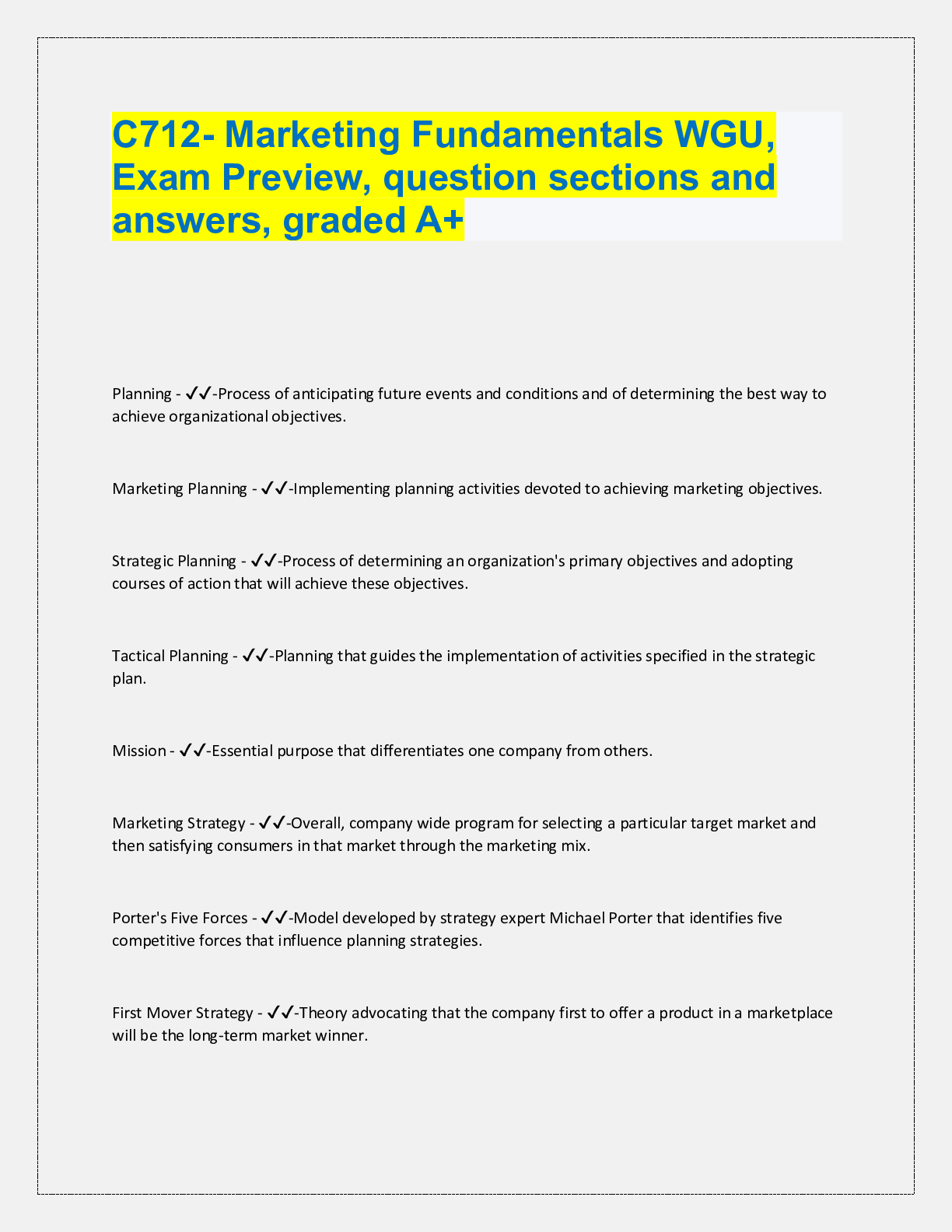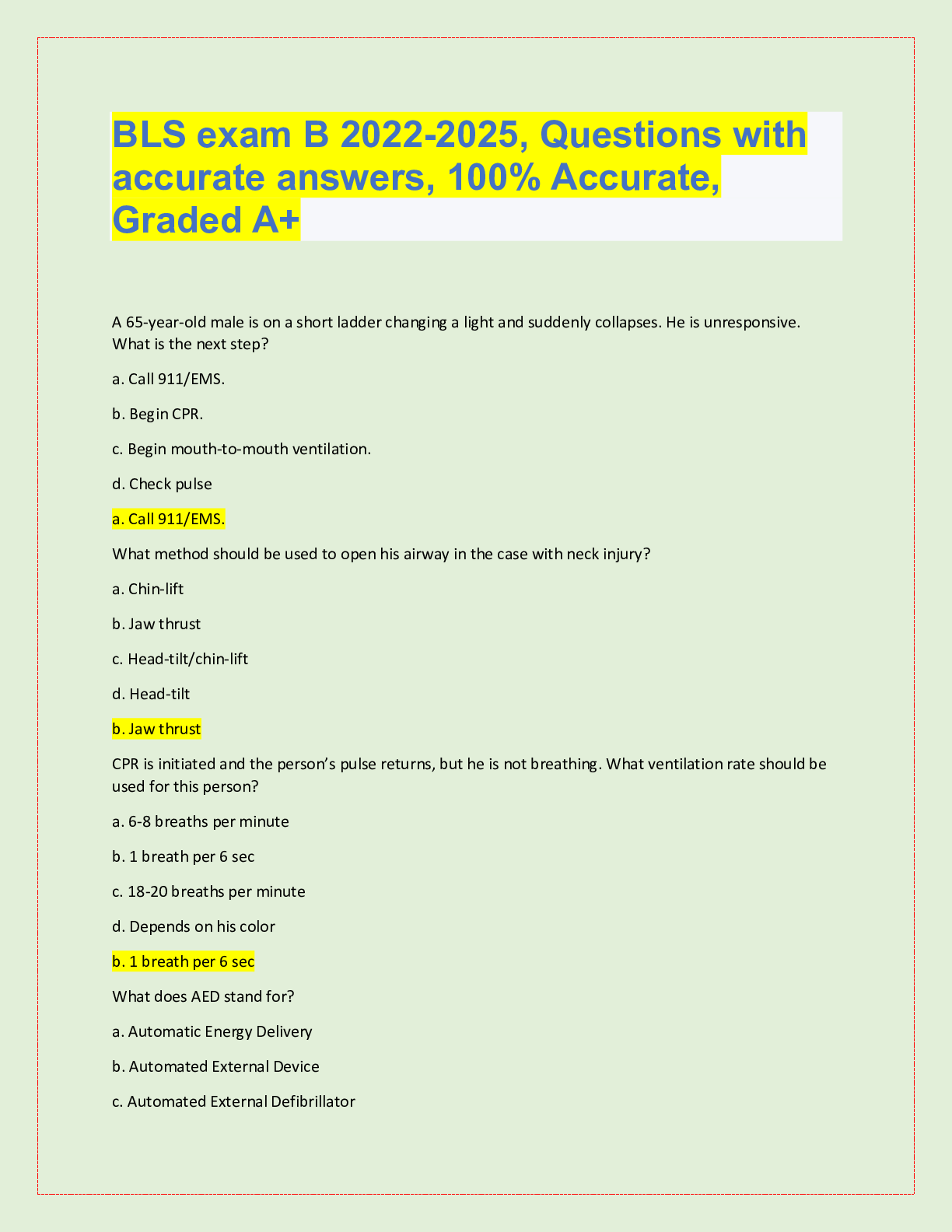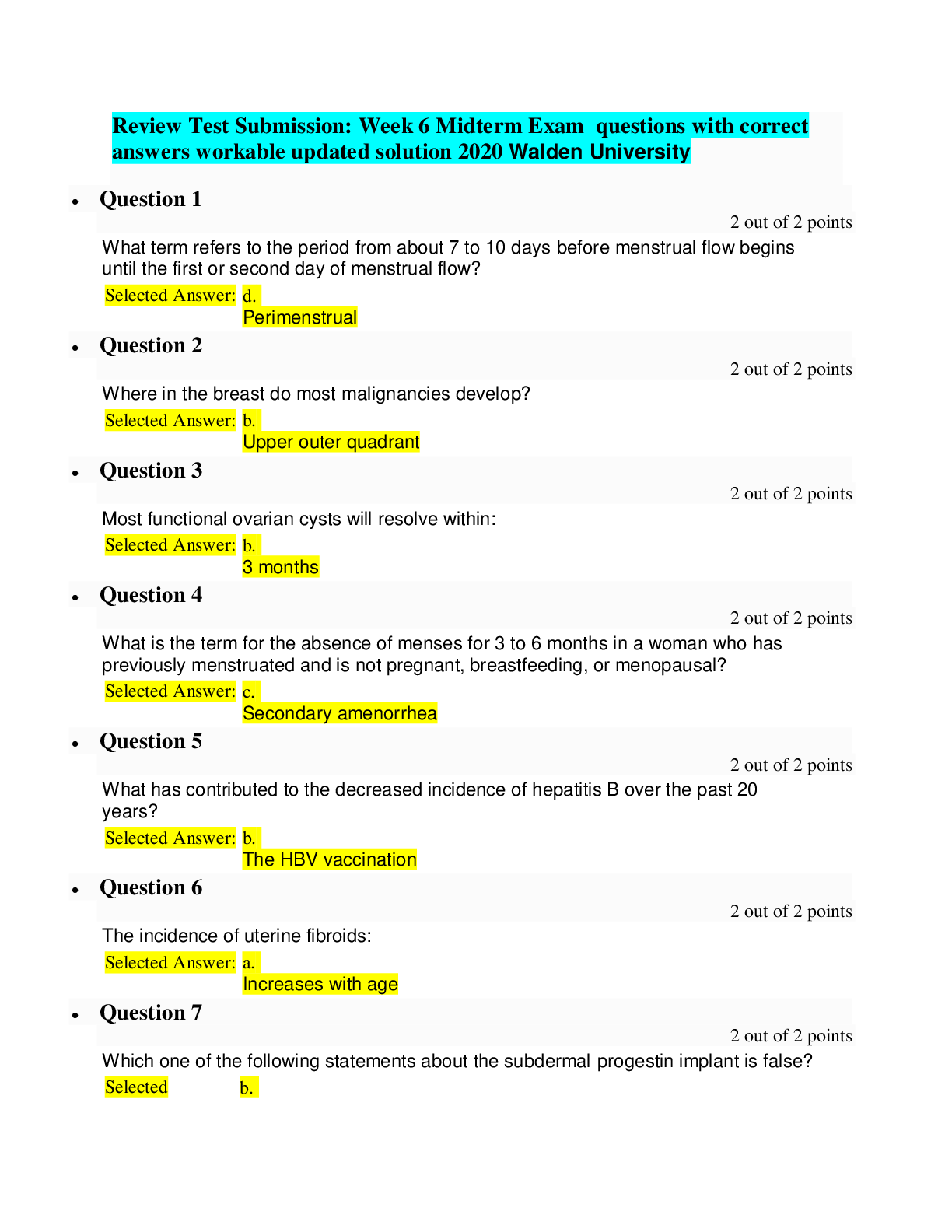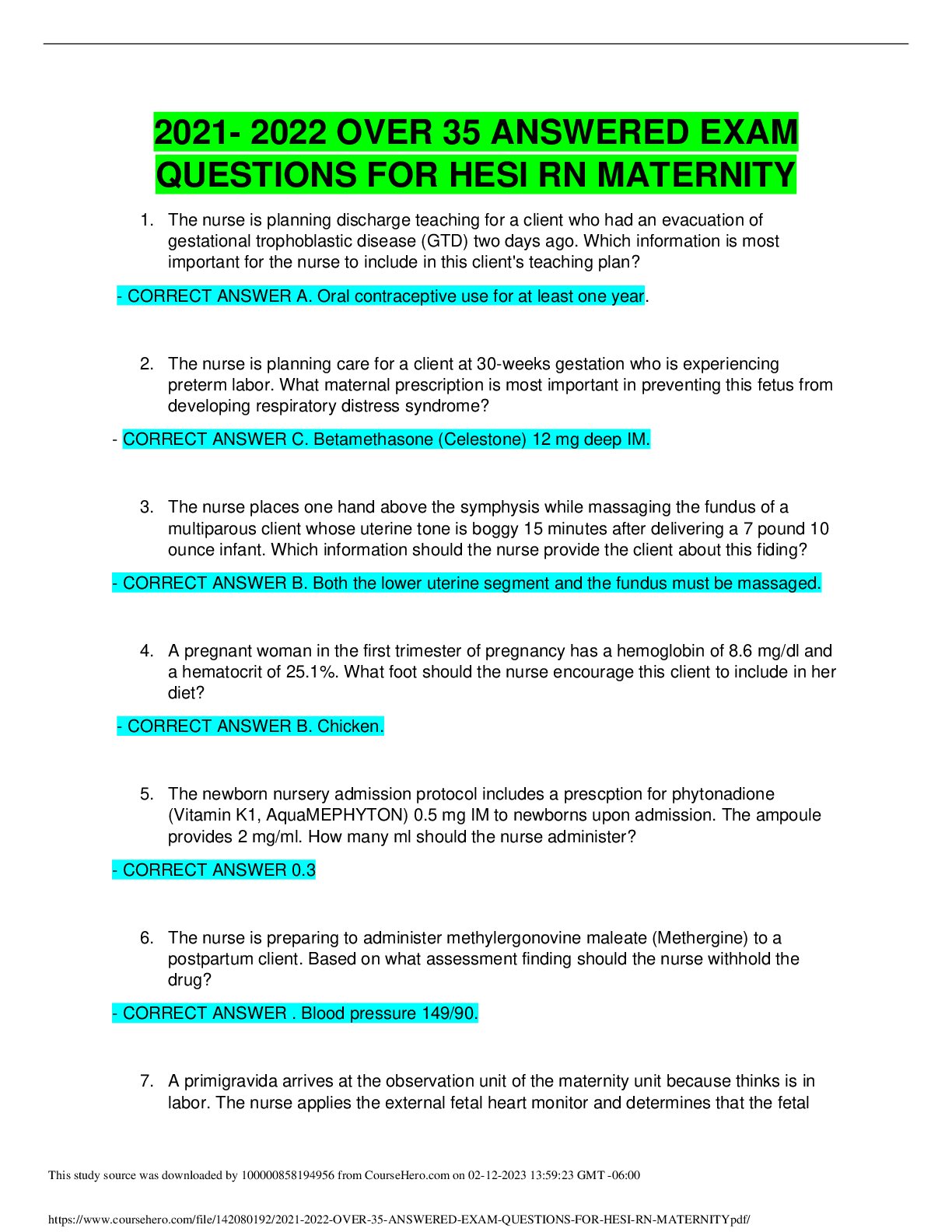Marketing > QUESTIONS & ANSWERS > WGU c712 latest update quiz#2,#3, #4, #5, #6, #7, #9, #10, #11. Top Exam Questions with accurate a (All)
WGU c712 latest update quiz#2,#3, #4, #5, #6, #7, #9, #10, #11. Top Exam Questions with accurate answers, Verified.
Document Content and Description Below
WGU c712 latest update quiz#2,#3, #4, #5, #6, #7, #9, #10, #11. Top Exam Questions with accurate answers, Verified. 1. The production possibilities frontier illustrates A. Goods and services t... hat people want. B. The limits to future growth of a nation. C. How money can be allocated among two kinds of goods. D. The minimum combination of goods and services that can be produced. E. The various combinations of output a nation can produce given its available resources and technology. - ✔✔-E. The various combinations of output a nation can produce given its available resources and technology. Which of the following are assumptions used when drawing a production possibilities frontier? * A. Only two goods are considered. B. Demand equals supply. C. The level of technology is constant. D. How much of each good people want. - ✔✔-A. Only two goods are considered. C. The level of technology is constant. In the production possibilities frontier model, an unattainable point lies A. On the production possibilities frontier. B. Inside the production possibilities frontier. C. Outside the production possibilities frontier. D. There are no unattainable points in the production possibilities frontier model. - ✔✔-C. Outside the production possibilities frontier. On a production possibilities frontier, 5 guns and 12 pounds of butter can be produced. At another point on the same frontier, 3 guns and 13 pounds of butter can be produced. Between these points, what is the opportunity cost of a pound of butter? A. 2 pounds of butter B. 2 guns. C. 0.2 guns. D. 0.5 guns. E. 2.4 guns. - ✔✔-B. 2 guns. 7. Production possibilities frontiers usually curve out and away from the origin because A. The more resources used to produce one good, the fewer resources are available to produce another good. B. As more of a good is produced, the opportunity cost decreases. C. Technological change happens. D. Some resources are better at producing one good, while other resources are better at producing the other good. E. As more of a good is produced, the opportunity cost doesn't change. - ✔✔-D. Some resources are better at producing one good, while other resources are better at producing the other good. If a society moves from a period of time with significant unemployment to a time with full employment, its production possibilities frontier will A. shift leftward. B. Shift rightward. C. Not shift because the society moves from one point on the frontier to a point inside the frontier. D. Not shift because the society moves from a point inside the frontier to a point on the frontier. E. Not shift because the society moves from a point on the frontier to a point outside the frontier. - ✔✔- D. Not shift because the society moves from a point inside the frontier to a point on the frontier. If Wendy can produce more of all goods than Tommy in an hour, then * A. Wendy has an absolute advantage in all goods. B. Wendy does not need to trade with Tommy in order to achieve the gains from trade. C. Wendy has a comparative advantage in all goods. D. Tommy has an absolute advantage in all goods. E. Only Tommy but not Wendy can benefit from trade between the two of them. - ✔✔-A. Wendy has an absolute advantage in all goods. Two islands, North Island and South Island, produce food and clothing. If North Island uses all of it resources on food production, it can produce 250 units of food. If North Island uses all of its resources to make clothing, it can make 100 units of clothing. Meanwhile, if South Island uses all of it resources on food production, it can produce 125 units of food. If South Island uses all of its resources to make clothing, it can make 100 units of clothing. Which island has the absolute advantage in food production? * North Island South Island Both Islands Neither Island - ✔✔-North Island Two islands, North Island and South Island, produce food and clothing. If North Island uses all of it resources on food production, it can produce 250 units of food. If North Island uses all of its resources to make clothing, it can make 100 units of clothing. Meanwhile, if South Island uses all of it resources on food production, it can produce 125 units of food. If South Island uses all of its resources to make clothing, it can make 100 units of clothing. Which island has the absolute advantage in clothing production? * North Island South Island. Both Islands. Neither Island. - ✔✔-Neither Island. Two islands, North Island and South Island, produce food and clothing. If North Island uses all of it resources on food production, it can produce 250 units of food. If North Island uses all of its resources to make clothing, it can make 100 units of clothing. Meanwhile, if South Island uses all of it resources on food production, it can produce 125 units of food. If South Island uses all of its resources to make clothing, it can make 100 units of clothing. For North Island, the opportunity cost of food is * 1 unit of clothing. 10 units of clothing. 0.4 units of clothing. 2.5 units of food - ✔✔-0.4 units of clothing. Two islands, North Island and South Island, produce food and clothing. If North Island uses all of it resources on food production, it can produce 250 units of food. If North Island uses all of its resources to make clothing, it can make 100 units of clothing. Meanwhile, if South Island uses all of it resources on food production, it can produce 125 units of food. If South Island uses all of its resources to make clothing, it can make 100 units of clothing. For South Island, the opportunity cost of clothing is * 2.5 units of food 1.25 units of food 1.25 units of clothing 1 unit of clothing - ✔✔-1.25 units of food Two islands, North Island and South Island, produce food and clothing. If North Island uses all of it resources on food production, it can produce 250 units of food. If North Island uses all of its resources to make clothing, it can make 100 units of clothing. Meanwhile, if South Island uses all of it resources on food production, it can produce 125 units of food. If South Island uses all of its resources to make clothing, it can make 100 units of clothing. Based on the theory of comparative advantage, * North should produce clothing. South should produce clothing. South should produce food. Both countries should produce what its residents need. - ✔✔-South should produce clothing. Other things remaining the same, the quantity of a good or service demanded will increase if the price of the good or service * A. Rises. B. Falls. C. Does not change. D. Rises or does not change. E. Rises or falls. - ✔✔-B. Falls. . A change in the demand for apples could result from any of the following EXCEPT * A. A change in the number of buyers. B. Increased preferences for fresh fruit consumption for health reasons. C. A change in the price of an apple. D. A change in the price of a banana. E. A change in income. - ✔✔-C. A change in the price of an apple. The phrase "a change in demand" most directly implies a * A. Movement along a demand curve. B. Movement along the price curve. C. Change in the quantity demanded of a good. D. Shift of the demand curve. E. Movement along the quantity curve. - ✔✔-D. Shift of the demand curve. When the price of oranges increases, A. The supply of oranges increases. B. The quantity of oranges demanded increases. C. The quantity of oranges supplied increases. D. The supply of oranges decreases. E. None of the above - ✔✔-C. The quantity of oranges supplied increases. Which of the following does NOT increase the supply of lightbulbs, that is, does NOT shift the supply curve of lightbulbs? A. An advance in the technology used to produce lightbulbs. B. An increase in the number of firms producing lightbulb C. A fall in the cost of the components used to assemble lightbulbs D. A rise the price of a lightbulb E. A change in the expected future price of a lightbulb - ✔✔-D. A rise the price of a lightbulb Which of the following decreases the supply of doughnuts? * A. A situation where the quantity of doughnuts demanded exceeds the quantity supplied B. An increase in the price of doughnuts. C. An increase in the price of a resource used to produce doughnuts, such as sprinkles D. A decrease in the demand for fried foods, such as doughnuts E. An increase in income if doughnuts are a normal good - ✔✔-C. An increase in the price of a resource used to produce doughnuts, such as sprinkles If input prices decrease, ceteris paribus, A. Quantity supplied will decrease. B. Supply will increase. C. Supply will decrease. D. Demand will increase. - ✔✔-B. Supply will increase Assume a market is in equilibrium. There is an increase in supply, but no change in demand. As a result the equilibrium price ________, and the equilibrium quantity ________. * A. Rises; increases. B. Rises; decreases. C. Rises; does not change. D. Falls; decreases. E. Falls; increases. - ✔✔-E. Falls; increases. Assume a competitive market is in equilibrium. There is an increase in demand, but no change in supply. As a result the equilibrium price ________, and the equilibrium quantity ________. A. Rises; increases. B. Rises; does not change. C. Falls; does not change. D. Falls; decreases. E. Falls; increases. - ✔✔-A. Rises; increases. A surplus of tomatoes means that A. At the current price of a tomato, the quantity demanded exceeds the quantity supplied. B At the current price of a tomato, the quantity demanded is less than the quantity supplied. C. The current price of a tomato is less than the equilibrium price. D. At the current price of a tomato, the quantity demanded equals the quantity supplied and the price will fall to restore the equilibrium. E. More information is needed to determine if the price of tomatoes is higher than, lower than, or equal to the equilibrium price. - ✔✔-B At the current price of a tomato, the quantity demanded is less than the quantity supplied. Suppose the equilibrium price of avocados is $2.00. If the actual price is above the equilibrium price, a A. Shortage exists and the price falls to restore equilibrium. B. Shortage exists and the price rises to restore equilibrium. C. Surplus exists and the price falls to restore equilibrium. D. Surplus exists and the price rises to restore equilibrium. E. Surplus exists but nothing happens until either the demand or the supply changes. - ✔✔-C. Surplus exists and the price falls to restore equilibrium. Which of the following would increase the equilibrium price of bananas? (Choose 2) * A. A sale on apples. B. A hurricane wiped out the banana crop in South America. C. An improvement in the technology for shipping bananas to the market. D. Medical research that demonstrates the cancer fighting ability of bananas. E. A decrease in income when bananas are a normal good. - ✔✔-B. A hurricane wiped out the banana crop in South America. D. Medical research that demonstrates the cancer fighting ability of bananas. If, at a specific price, quantity demanded is greater than quantity supplied, then price will A. Increase until the excess supply is eliminated. B. Decrease until the excess supply is eliminated. C. Increase until the excess demand is eliminated. D. Remain unchanged, and quantity demanded will decrease. E. Decrease, and quantity supplied will increase. - ✔✔-C. Increase until the excess demand is eliminated. The demand for dog food increases while the supply increases. The equilibrium price of dog food ________, and the equilibrium quantity ________. A. perhaps changes but we can't say if it increases, decreases, or stays the same; increases B. perhaps changes but we can't say if it increases, decreases, or stays the same; decreases C. falls; perhaps changes but we can't say if it increases, decreases, or stays the same D. rises; perhaps changes but we can't say if it increases, decreases, or stays the same E. falls; increases - ✔✔-A. perhaps changes but we can't say if it increases, decreases, or stays the same; increases The demand for avocados increases while the supply decreases. The equilibrium price of avocados ________, and the equilibrium quantity ________. A. Rises; decreases. B. Falls; perhaps changes but we can't say if it increases, decreases, or stays the same. C. Falls; increases. D. Does not change; perhaps changes but we can't say if it increases, decreases, or stays the same. E. Rises; perhaps changes but we can't say if it increases, decreases, or stays the same. - ✔✔-E. Rises; perhaps changes but we can't say if it increases, decreases, or stays the same. The price elasticity of demand is a measure of A. The equilibrium price of a product. B. Buyers' responsiveness to changes in the price of a product. C. The amount of a product purchased when income changes. D. Whether a product is a substitute or complements. E. How much a change in demand affects the equilibrium price. - ✔✔-B. Buyers' responsiveness to changes in the price of a product. The elasticity of demand is used to A. Determine whether consumers will buy a product. B. Find the market equilibrium. C. Measure how responsive consumers are to a change in price. D. Determine which direction the demand curve shifts with a change in income. E. Determine the size of a shortage or surplus. - ✔✔-C. Measure how responsive consumers are to a change in price. If the percentage change in price is 10 percent and the demand is elastic, then the percentage change in the quantity demanded. A. Is greater than 0 but less than 10 percent. B. Is larger than 10 percent. C. Equals 0 percent. D. Equals 10 percent. E. Cannot determine with this information. - ✔✔-B. Is larger than 10 percent. Which of the following influence the price elasticity of demand? (Choose 2) * A. The availability of complements. B. Whether or not the good is normal. C. Resource allocation method. D. Availability of substitutes. E. Proportion of income spent on good. - ✔✔-D. Availability of substitutes. E. Proportion of income spent on good. If the price elasticity of demand for a good is 2, then a 10 percent increase in the price of that good _______________ the quantity demanded by __________ percent. A. Increases; 20 B. Decreases; 2 C. Decreases; 10 D. Decreases; 20 E. Increases; 2 - ✔✔-D. Decreases; 20 Suppose the demand for cherries sold from roadside stands in Michigan is perfectly elastic. The owner of one roadside stand raises the price of cherries by 10%, as a result A. Zero cherries are sold at this stand. B. No change in the quantity demanded at this stand. C. A 10% decrease in the quantity demanded at this stand. D. A 10% increase in the quantity demanded at this stand. E. All available cherries will be sold. - ✔✔-A. Zero cherries are sold at this stand. Suppose that the demand for ambulance service is perfectly inelastic. This would mean that a 50% increase in price would lead to A. A 50% decrease in the quantity demanded. B. A 50 percent increase in demand. C. A 50 percent decrease in the quantity demanded. D. No change in quantity demand. E. Ambulance services no longer demanded. - ✔✔-D. No change in quantity demand. After movie streaming services became popular, movie theaters found that their revenue declined. In an attempt to boost revenues, the local movie theater raised the price of a movie. And their revenues fell even more. What can explain this result? A. The demand for movie tickets is elastic because of many substitutes. B. The demand for movie tickets became inelastic after the price increase. C. Movie theater tickets are inferior goods. D. The demand for movie theater tickets is inelastic because there is only one way to see a new movie. E. None of the above. - ✔✔-A. The demand for movie tickets is elastic because of many substitutes. A gas station lowers the price of gasoline. The price elasticity of demand for gasoline is 0.2. What happens to the gas station's total revenue? A. It increases. B. It decreases. C. It stays the same. D. More information is needed. - ✔✔-B. It decreases. If a 10 percent increase in the price of good X increases the demand of good Y by 5 percent, then X and Y are A. Complements and the cross price elasticity equals 2. B. Complements and the cross price elasticity equals 1/2. C. Substitutes and the cross price elasticity equals 1/2. D. Substitutes and the cross price elasticity equals 2. E. Inferior goods. - ✔✔-C. Substitutes and the cross price elasticity equals 1/2. The cross elasticity of demand for coffee and creamer is likely to be A. Positive because they are substitutes. B. Positive because they are complements. C. Negative because they are substitutes. D. Negative because they are complements. E. Positive because they are normal goods. - ✔✔-D. Negative because they are complements. Mike purchases fewer boxes of cookies when his income falls. Cookies must be A. A normal good. B. An inferior good. C. Elastic. D. Inelastic E. A complement for milk. - ✔✔-A. A normal good. If a 10 percent increase in income leads to a 5 percent decrease in the demand for a good, the income elasticity of demand equals ________ and the good is ________ good. A. 1/2; a normal. B. -1/2; an inferior. C. 2; a normal. D. -2; a normal. E. -5; an inferior. - ✔✔-B. -1/2; an inferior. The price elasticity of supply measures A) the percentage change in supply from a percentage change in demand. B) the extent to which the quantity supplied of a good changes when the price of a good changes, other things remaining the same. C) the slope of the supply curve. D) how the equilibrium price changes in response to a change in the equilibrium quantity supplied. E) Both answers B and C are correct. - ✔✔-B) the extent to which the quantity supplied of a good changes when the price of a good changes, other things remaining the same. Marginal Benefit is the a) increase in net benefit that a person receives from consuming another unit of a good. b) additional efficiency from producing another unit of a good. c) increase in profit from producing another unit of a good. d) change in total benefit that occurs when a person consumes another unit of the good. e) total benefit from consuming all the units of the good or service. - ✔✔-d) change in total benefit that occurs when a person consumes another unit of the good. The cost of producing one more unit of a good or service is equal to its * a) marginal benefit. b) producer surplus. c) marginal expenditure. d) consumer surplus. e) marginal cost. - ✔✔-e) marginal cost. Based on the marginal decision rule, Jane should buy another cup of coffee if * a) the marginal benefit of coffee is equal to its marginal cost. b) the net benefit of coffee is positive. c) the marginal benefit of coffee is more than the marginal cost. d) the total benefit of coffee is increasing. e) her marginal benefit of coffee is increasing. - ✔✔-c) the marginal benefit of coffee is more than the marginal cost. A point on the demand curve shows the * a) minimum price that people are willing to pay for another unit of a good. b) dollars' worth of other goods that people must sacrifice to consume another unit of the good. c) maximum price that people are willing to pay for another [Show More]
Last updated: 2 years ago
Preview 1 out of 36 pages

Buy this document to get the full access instantly
Instant Download Access after purchase
Buy NowInstant download
We Accept:

Also available in bundle (1)

WGU C712 Exam Bundle, verified
WGU C712 OA Exam prep questions with answers, 100% Accurate, Verified.
By Topmark 2 years ago
$30
16
Reviews( 0 )
$12.00
Can't find what you want? Try our AI powered Search
Document information
Connected school, study & course
About the document
Uploaded On
Mar 13, 2023
Number of pages
36
Written in
Additional information
This document has been written for:
Uploaded
Mar 13, 2023
Downloads
0
Views
86















.png)








